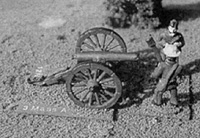From the Wargamer's Digest, October 1977
During the Napoleonic Wars, the 12 pound gun was the standard heavy gun on the battlefield for the French. Within Napoleon's Corps system, an 8 gun battery was attached to each corps as a reserve and a number of batteries (known as companies) were located in the army reserve. On occasion in the corps and often in the army reserve, 6 guns were oftenjoined with 2 howitzers for 8 gun batteries. Usually drawn by 6 horses, the 12 pound guns were of brass, carriages of wood, fittings of iron (painted black).
The wooden carriages had been a blue (varying from light to royal blue) during the Bourbon monarchy and were painted olive green during Napoleon's reign. The construction of barrel and carriage were based on the Gribeauval system. Jean Baptiste Gribeauval had redesigned French artillery by 1767 to include less ornate and lighter gun barrels as well as sturdier but lighter gun carriages and limbers. Iron bands for support, elevating screws and a small ammunition box, which could be carried on the gun trail itself were all developed. Caissons for ammunition were also designed. In 1774 this system came into general use with the French army and was retained throughout the Napoleonic wars.
The French also used a device known as the sabot to make one-piece cartridges for rapid loading and firing. Designed as a wooden disk, the sabot was placed between ball and powder (often bagged in flannel for complete burning), and the two were bound or sewn respectively onto the sabot. In close situations where rapid firing was called for, the 12 pounder could get off a respectable number of shots quickly.
Tactically, the 12 pounders were often used by Napoleon to blow gaps in the opponent's line once cavalry, light infantry and the lighter artillery had fixed him in place. The longer the wars continued, the more 12 pounders came into play under Napoleon. In 1807 at Friedland, four 12 pounders joined 34 other guns to form three makeshift batteries which actually advanced against the Russians. For each gun on campaign, nomial support ammunition included a minimum of 175 rounds for corps and regimental artillery and 350 rounds for Guard artillery. Rogers mentions the 1809 campaign where the Guard artillery had 48 guns of which twelve were 12 pounders (28, 6 pounders and 8, 24 pound howitzers). Seventy-two ammunition wagons were provided for the 12 pounders.
By 1813, the Guard artillery became a major tool in Napoleon's efforts to recover from his defeat in Russia. Increasingly composed of 12 pounders and some larger howitzers, the Guard artillery became almost indispensable. At Dresden in 1813 and again at Leipzig, artillery played an important role. But without the support of well-trained infantry and cavalry to follow up temporary advantages gained by the guns, the French were doomed.
 Editor's Note: This gun should not be confused with the 12 pounder Napoleon of
American Civil War fame (pictured here!). That weapon was developed in France in 1857
and named after Emperor Napoleon III. Large smoothbore Napoleons shot devastating
volleys of double and treble cannister that decimated attacking Union and Confederate
infantry.
Editor's Note: This gun should not be confused with the 12 pounder Napoleon of
American Civil War fame (pictured here!). That weapon was developed in France in 1857
and named after Emperor Napoleon III. Large smoothbore Napoleons shot devastating
volleys of double and treble cannister that decimated attacking Union and Confederate
infantry.
Specifications
Gun type: French 12 pound artillery
Crew: 8 artillerists, 7 nonspecialists
Ammunition: ball, canister
Cassion Storage: 48 ball, 20
canister
Trail Chest Storage: 9 ball
Effective Range:
- Shot- 900 meters (984 yards)
Canister- 600 meters (656 yards)
Max Range: 1800 yards (1969 yards)
Average
Rate of Fire: 1 round per min.
Barrel Weight: 2172 lbs.
Carriage Weight: 2192 lbs.
Bibliography
David Chandler. The Campaigns of Napoleon. New York: The Macmillan Co.,
1966
Patrick Griffith. French Artillery. London: Almark, 1976.
Michael Head. French Napoleonic Artillery. London; Almark 1970.
Harold Peterson. Round Shot and Rammers. Han-isburg, PA: Stackpole Books,
1969.
Col. H. C. B. Rogers. Napoleon's Army. New York: Hippocrene, 1974.
Back to Table of Contents The Messenger November 2002
Back to The Messenger List of Issues
Back to MagWeb Magazine List
© Copyright 2002 by HMGS/PSW.
This article appears in MagWeb (Magazine Web) on the Internet World Wide Web.
Other articles covering military history and related topics are available at http://www.magweb.com